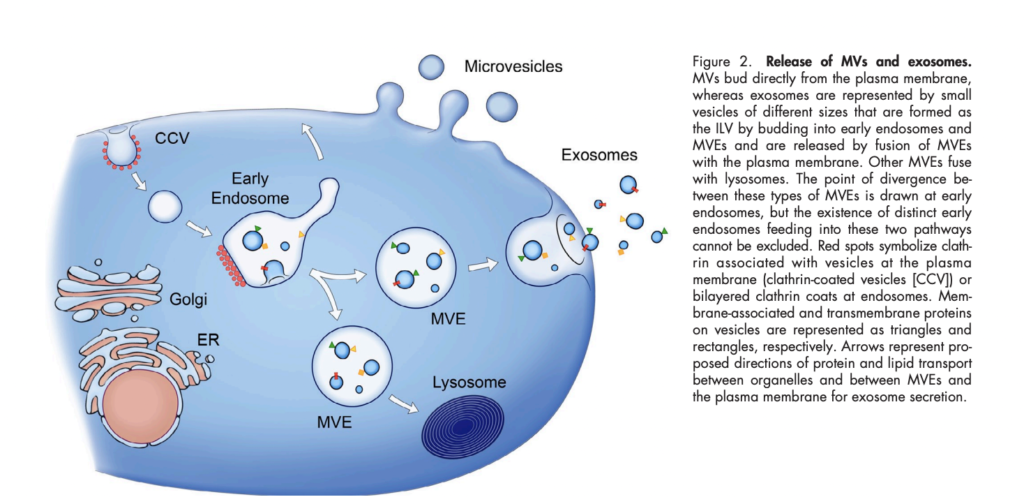Exosomes
Exosomes are small, membrane-bound vesicles that are secreted by cells and contain a variety of biomolecules, including proteins, lipids, and nucleic acids.
These vesicles have gained significant attention in recent years due to their potential usefulness in medicine.
In this essay, we will explore what exosomes are and their usefulness in medicine.
What are exosomes
Exosomes are formed through the inward budding of the plasma membrane, resulting in the formation of intracellular vesicles that are then released into the extracellular space.
These vesicles can be taken up by neighboring cells or transported to distant sites in the body, where they can influence cellular behavior and communication.
Exosomes have been found to play a role in a variety of physiological processes, including immune regulation, tissue repair, and cancer progression.

Creation of exosomes. FROM: Graça Raposo and Willem Stoorvogel. Extracellular vesicles: exosomes, microvesicles, and friends. J Cell Biol . 2013 Feb 18;200(4):373-83. USED WITH CREATIVE COMMONS LICENSE. All credit to original source
One of the most promising applications of exosomes in medicine is their potential use as diagnostic and therapeutic tools.
Exosomes can be isolated from various bodily fluids, including blood, urine, and saliva, and their contents can be analyzed to provide information about the health status of the individual.
For example, exosomes derived from cancer cells may contain specific biomarkers that can be used to diagnose the presence of cancer or monitor the progression of the disease.
Exosomes also have potential therapeutic applications. They can be engineered to deliver specific molecules, such as drugs or genetic material, to target cells.
This approach has been used to deliver therapeutic agents to cancer cells, for example, by engineering exosomes to express tumor-specific antigens that can stimulate an immune response against the cancer cells.
Exosomes have also been used to deliver small interfering RNA (siRNA) to target cells, which can be used to silence specific genes that are involved in disease processes.
In addition to their diagnostic and therapeutic potential, exosomes also have potential applications in regenerative medicine.
Exosomes derived from stem cells have been found to promote tissue repair and regeneration in various animal models. These exosomes contain a variety of growth factors and other molecules that can stimulate cell proliferation and differentiation, leading to tissue repair and regeneration.

The biology, function, and biomedical applications of exosomes RAGHU KALLURI HTTPS://ORCID.ORG/0000-0002-2190-547X AND VALERIE S. LEBLEU
In conclusion
exosomes are small, membrane-bound vesicles that have gained significant attention in recent years due to their potential usefulness in medicine.
They have diagnostic and therapeutic applications, as well as potential applications in regenerative medicine.
As research in this field continues, it is likely that exosomes will become an increasingly important tool in the diagnosis and treatment of a variety of diseases.
Exosomes : Potential in hair loss
Hair loss, also known as alopecia, is a common condition that affects millions of people worldwide. It can be caused by a variety of factors, including genetics, hormonal imbalances, and autoimmune disorders. While there are several treatments available for hair loss, including medications and hair transplant surgery, these treatments are not always effective and can have side effects.
Exosomes derived from stem cells have been found to promote hair growth in animal models. These exosomes contain a variety of growth factors and other molecules that can stimulate hair follicle stem cells, leading to hair growth. In a study published in the journal Stem Cells Translational Medicine, researchers found that exosomes derived from adipose-derived stem cells (ADSCs) promoted hair growth in mice with alopecia. The researchers found that the exosomes stimulated the proliferation of hair follicle stem cells and increased the expression of genes involved in hair growth.
Another study published in the journal Scientific Reports found that exosomes derived from human hair follicle dermal papilla cells (HFDPCs) promoted hair growth in mice with alopecia. The researchers found that the exosomes contained a variety of growth factors and other molecules that stimulated hair growth and increased the size of hair follicles.
While these studies are promising, more research is needed to determine the safety and efficacy of exosome-based therapies for hair loss in humans. It is also important to note that exosome-based therapies are still in the experimental stage and are not yet available for clinical use. However, the potential of exosomes in the treatment of hair loss is an exciting area of research that may lead to new and effective treatments for this common condition.
Reference
Graça Raposo and Willem Stoorvogel. Extracellular vesicles: exosomes, microvesicles, and friends. J Cell Biol . 2013 Feb 18;200(4):373-83.
https://pubmed.ncbi.nlm.nih.gov/23420871/
The biology, function, and biomedical applications of exosomes RAGHU KALLURI HTTPS://ORCID.ORG/0000-0002-2190-547X AND VALERIE S. LEBLEU
https://www.science.org/doi/10.1126/science.aau6977

